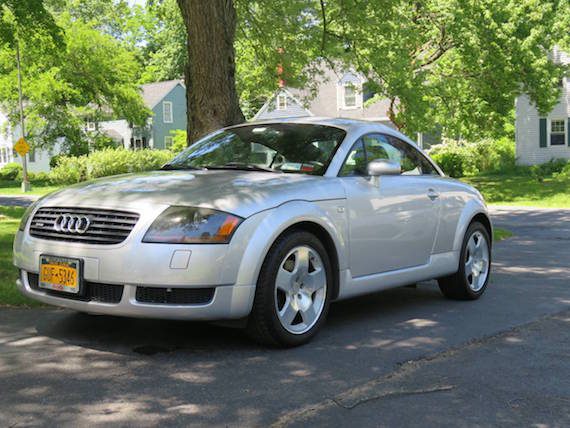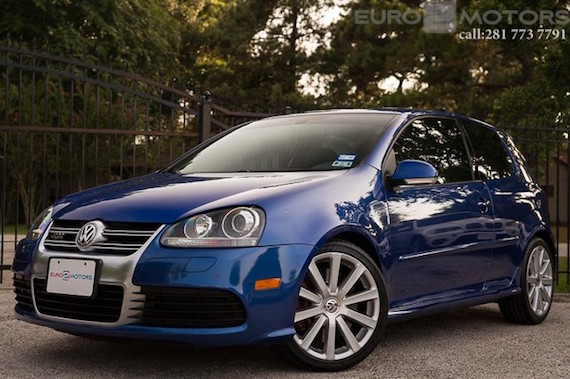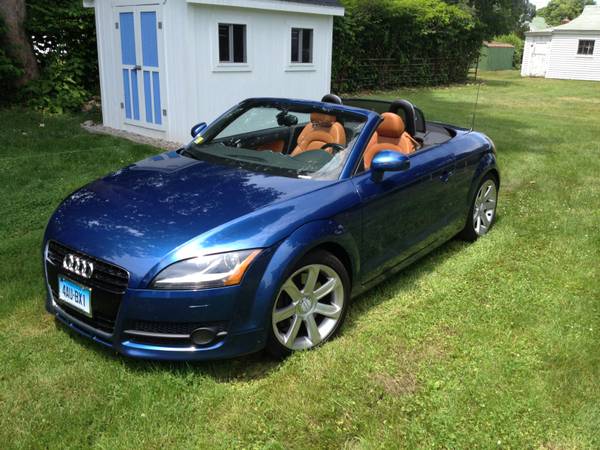 I went to college in London in 2000, about the same time that the first generation TT started to appear on British roads. Because my dorms were in a posh part of town, there were always a few of these parked nearby. The car’s styling struck me as extraordinary. It captured something of the millennial zeitgeist: a minimalist, Bauhaus-esque design that artfully blended lines and curves on the outside, with a bespoke-feeling cockpit on the inside featuring splashes of brushed aluminum and baseball-glove stitching on the leather seats. Back then, I had ambitions to become a lawyer, and this was the perfect car, I thought, for a young single man about town. The perfect yuppie’s car.
I went to college in London in 2000, about the same time that the first generation TT started to appear on British roads. Because my dorms were in a posh part of town, there were always a few of these parked nearby. The car’s styling struck me as extraordinary. It captured something of the millennial zeitgeist: a minimalist, Bauhaus-esque design that artfully blended lines and curves on the outside, with a bespoke-feeling cockpit on the inside featuring splashes of brushed aluminum and baseball-glove stitching on the leather seats. Back then, I had ambitions to become a lawyer, and this was the perfect car, I thought, for a young single man about town. The perfect yuppie’s car.
Tag: Haldex
We don’t spend a lot of time on these pages talking about the Audi TT, and that’s a disservice to what is a great car. It’s often called a pretend sports car, but dismiss for a moment that it’s not a Porsche 911 and consider what it is. Starting as a show car in 1995 (hard to believe!), most thought it would never come to market like the futuristic look of the concept. But surprisingly the look was almost identical; the slinky exterior and modern looking interior managing to well mask the Golf underpinnings. The turbocharged motor packed 180 horsepower to start, but the promise of more in the future sounded great because of the Haldex-differential “quattro” drivetrain. In many ways, it was always the promise of more power and special editions that somewhat overshadowed the 180 horsepower model, but today we have a lovely example of the lower power Coupe:
CLICK FOR DETAILS: 2001 Audi TT Coupe 180 quattro on eBay
1 CommentVAG’s decisions on who would be able to shift their own gears have always been a bit confusing, but the period of the 3.2 VR6 is really where this came to a head for U.S. customers. In 2004, Volkswagen brought their hottest Golf (finally!) to our market, featuring the singing VR6 in 6-speed manual only form with the R32. Great, but Audi offered the same platform in slinkier TT 3.2 Quattro form. However, fans of manual shifting were overlooked as Audi opted to bring the top TT here only with DSG. This carried over to the A3 model range, where you could get a 3.2 quattro but only with the DSG box. When it came to the next generation, VAG opted to change this formula. As it had been a fan favorite, you’d assume that the R32 would retain the same layout. But no, Volkswagen removed the manual option and the Mk.5 based R32 became DSG-only. So that would hold true in the bigger budget, typically more tech-heavy TT too, right? Wrong, as in the 2nd generation, Audi finally opted to allow buyers to select a manual in either Coupe or Roadster form:
CLICK FOR DETAILS: 2008 Audi TT Roadster 3.2 quattro on New London Craigslist
4 Comments
One week ago today I enthusiastically wrote up one of my preferred daydream cars, the original MkIV R32. When it came out, the R32 was the superGolf I’d always dreamed of but thought only existed in Hans Dahlback’s shop of terror. The MkIVs obviously still entice me today with wide fenders, deep growls, and a VR6/6-speed/4Motion combo that makes them very special hatchbacks indeed. Where I caught myself was trying to make an argument that MkIV prices have fallen far enough to be a great performance bargain.
MkIV R32s are certainly accessible hot hatch performance, but it’s not a bargain if you can get the following model, 4 years newer with nicer equipment, a little more power, and lightning-fast DSG for the same price. This MkV R32 brings all of that and fewer miles while still ringing in around $15k. The MkV may be in the running for the least desirable generation of Golfs, but the features outweigh the generational spite. With 250hp, all wheel drive, and a very sharp interior, this is an even better performance value than last week’s blue R32.






